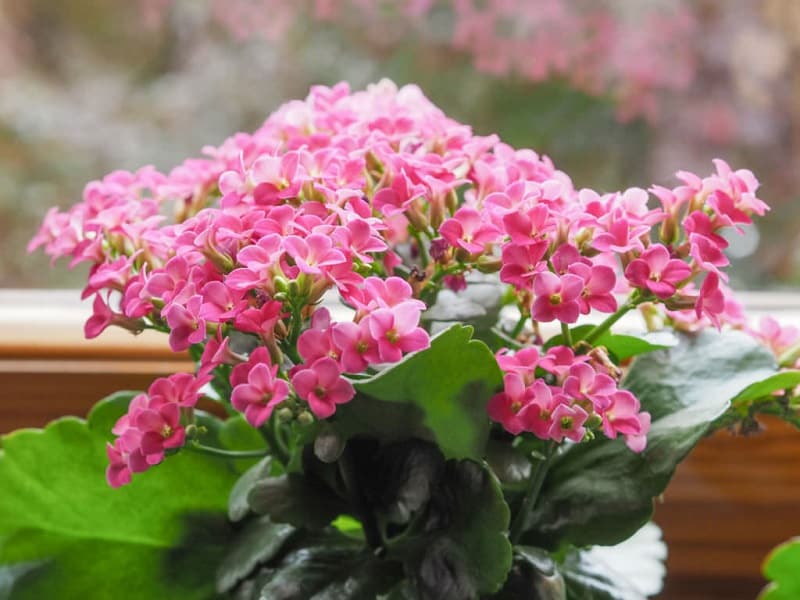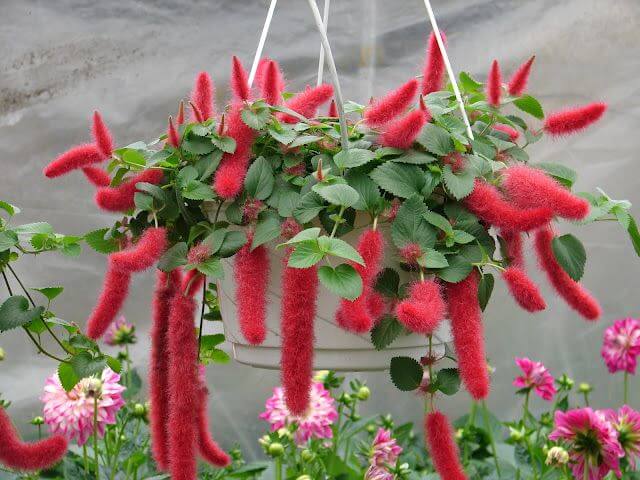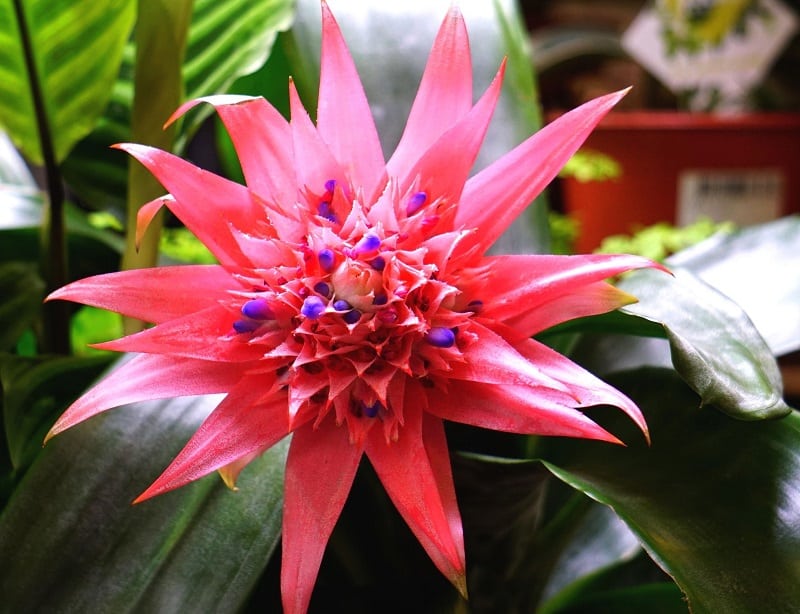How would you like to have a complete list of indoor flowering plants that bring bright blooms to your home, office, or garden for the majority part of the year?
That would be pretty epic, right?
Well, this is entirely possible, and I will share all of them with you in today's article.
It’s not just plain, scientific names accompanied by long, boring text; there are plenty of photos, too. All you have to do is bookmark this article as a reference so that you can come back to it as many times as you wish.
I am going to list the most beautiful indoor flowering plants that you can easily grow in your home by leveraging the skills you already have, tactically selecting the ones you like, and if you’re a complete beginner, there is even a brief description of each plant to give you a head-start!
Sound good? Let’s get to it.
27 Best Indoor Flowering Plants for Your Home
1. African Violet

Saintpaulia ionantha, commonly called the African violet, is one of the most satisfactory flowering houseplants. It is a low, compact plant with attractive dark green, thick, hairy leaves.
The violet-like flowers are borne in small panicles just above the foliage.
Plants that are kept in good growing condition, flower almost always continuously.
Here’s a great book that will teach you how to grow African violets that flower 365 days a year.
2. Begonia

This hardy perennial plant brings bright blooms to your home and garden for most of the year.
I have a wax begonia on my balcony, and it’s gorgeous! Begonias come in many different shapes, colors, and sizes.
They are easy to grow and take care of both indoors and outdoors.
Always water your wax begonia by hand using a hose or watering can. If you must water from overhead, for example, using a sprinkler, do it in the morning so the leaves can dry out before nightfall.
The best begonia types you can grow indoors are Wax Begonia, Angel-wing Begonia, and Rieger Begonia.
3. Bromeliad

Image credit: Bromeliad Society of NSW
Bromeliads are beautiful, easy-to-grow indoor and outdoor plants that add texture and color to your home.
Whether it's the variegated ones that thrive in direct sun or the soft green-leaved ones that are naturally accustomed to growing under a tree canopy with partial sun and shade, bromeliads show remarkable adaptability to different light conditions.
These plants will obviously survive for a while in lower light conditions. Still, they sometimes need a fair amount of direct sunlight to initiate flowering, pupping, and bringing out their color.
Placing them near a window will give them a better chance of thriving.
4. Orchids

Image credit: Better Homes & Gardens
Orchids are amongst the most popular indoor flowering plants.
Many hybrids, designed to thrive in home conditions, are remarkably easy to grow and bloom, even for beginners.
Most of their roots will be above the pot, sprawl outside the container, and even along the shelf surface. This is perfectly normal. So, please do not cut them off.
With indirect light from an east or west window, your orchids will do well under average room temperatures.
During the short days in the winter, they can even be moved to direct light or placed in a south window. Orchids can be placed in an interior room or office desk under a grow light.
Here is an excellent article on how to grow and care for indoor orchids.
5. Christmas Cactus

A healthy Christmas cactus in full bloom makes a great gift or decoration for your interior.
Christmas cactus is easy to care for and can be grown indoors throughout the year. The flowers range in color from yellow, salmon, pink, fuchsia, and white or combinations of those colors.
When a Christmas cactus is taken to its permanent home, it should be placed in a sunny indoor location.
A north or east window gives the ideal light. If you want to grow it indoors in a south or west window, you should shade the plant with thin curtains.
Read: 13 Effective Ways to Save a Dying Cactus Fast
6. Peace lily

Peace Lily is a herbaceous perennial typically grown as a houseplant.
It is popular as a specimen or accent in interior groupings for its deep-green glossy foliage and white blooms that are intermittent in medium lighting and long-lasting.
The plant has no specific bloom time but flowers freely and tolerates heavy shade.
The Peace Lily does best indoors in moist but not soggy soil, which makes it ideal for a bathroom plant. You should allow the soil to dry between waterings but not wilt, which causes the leaves to turn yellow.
7. Scented Geranium

While scented geraniums do flower, the flowers are often secondary in importance and not all that attractive. They are mainly grown for their attractive and highly scented foliage.
Fragrances can run from apple to mint to lemon to coconut to rose.
Because they will not overwinter outdoors in cold climates, they are best grown as container indoor flowering plants that can be moved indoors for the winter.
8. Flowering Kalanchoe

Kalanchoe (Kalanchoe blossfeldiana) is a popular houseplant typically available for sale in late winter and spring. It is a durable flowering potted plant requiring very little maintenance in the home or office.
With good care, kalanchoes may be grown to rebloom the next season.
After flowering, shift the plant to a slightly larger pot. Kalanchoes are succulents that grow best in well-drained and well-aerated potting soil, such as 60% peat moss, and 40% perlite.
Cut back tall growth and old flower stems.
Keep well-watered in a sunny, warm window.
9. Jasmine

Jasmine, with its intoxicating fragrance and stunning blooms, is a vine that captivates as an indoor flowering plant.
To grow jasmine well, provide some direct sunlight in the summer, constant moisture throughout the year (although a bit drier in the winter), and cooler temperatures in the fall to stimulate flowering.
These plants are much more cold-tolerant than many people think and can tolerate fall temperatures of 40 degrees Fahrenheit.
If your plant doesn't bloom, chances are it didn't get a cool period in the fall, so it needs to stimulate blooms.
If you’ve never grown jasmine indoors before, start with J. polyanthum – which is much easier to handle.
If you want to learn how to grow Jasmine indoors, read this article - Growing Jasmine Indoors: Care Of Indoor Jasmine Plants.
10. Chenille Plant

Acalypha hispida, or the chenille plant, is a flowering shrub that belongs to the family Euphorbiaceae.
Chenille plant is hardy in frost-free areas where it is used as a year-round flowering shrub. In most areas, it is sold as a spring or fall flowering pot plant not associated with any particular holiday.
It is also well suited to the flowering border or large container plantings on the patio.
You should provide full sun and routine fertilization during the growing season to encourage new growth and normal watering frequency. You can keep it as a houseplant but place it in a sunny location, such as near the window.
11. Silver Vase Plant

Aechmea fasciata, commonly known as Silver Vase, is a different type of bromeliad with beautiful flowers.
The attractive silver-grey, banded foliage of this easy-care bromeliad is a perfect background for the brilliant, springtime flower stalk which emerges from the tight center rosette of leaves.
The flower stalk comprises a cluster of rosy pink bracts nestled in pale blue flowers that change to deep roses. The long-lasting pink bracts are most noticeable.
The plants grow best in partial shade in moisture-retentive but well-drained soil.
12. Laceleaf

Also commonly known as anthurium, tailflower, or flamingo flower, laceleaf is amongst the most common indoor flowering plants grown for their brightly colored flower spathes and their ornamental leaves.
They need bright but indirect light.
Blooms in wild tropical areas in spring to summer; desired in interiors for long-lasting, pink to reddish inflorescence and erect, deep green leaves; spadix is at right angle to spathe and is twisted like a corkscrew in some species; used in interiorscapes as specimen or temporary flowering display.
Anthuriums prefer medium to high light, moist soil, and low to medium relative humidity; they do not have serious pest problems.
13. Oxalis (Shamrock plant)

Oxalis triangularis is a low-growing foliage plant for the garden that also makes for an attractive indoor plant with rich, vibrant purple leaves.
Oxalis are fun to grow because they are highly photophilic—that is, they open and close not only their blooms but also their leaves in response to light.
Something so dramatic to watch in Plant Kingdom!
14. Crown of Thorns

If you need a unique houseplant in your home, the crown of thorns plant is the best choice.
Classified as a succulent, the crown of thorns (Euphorbia milii) has thick fleshy leaves and stems adapted for water storage.
One reason this plant is such a great choice for warmer areas is that it's heat tolerant and tolerates salt spray.
Because it doesn’t mind drying out, it makes a good flowering container plant.
15. Cape Primrose
The Cape Primrose (Streptocarpus) is a relative of African Violets and prefers the same bright but indirect light growing conditions.
Their velvety, long green leaves and floral sprays that rise above the foliage create a stunning plant for a windowsill garden.
These houseplants thrive in warm, dry areas with ideal temperatures ranging from 60-75 degrees Fahrenheit.
16. Guppy Plant

The guppy plant is another African violet relative that blooms mostly during summer, but with enough light, it could bloom throughout the year.
Their dramatic flower appearance resembles dangling goldfish, which makes them an ideal choice for hanging baskets.
17. Amaryllis

Amaryllis may be purchased as bare or planted bulbs and are prized for their exotic trumpet-shaped flowers born on 1 to 2-foot leafless stalks or scapes.
They add dramatic color to homes and gardens and make wonderful gifts to gardeners, from beginners to experts.
Amaryllis grow best in narrow containers, which may be made of plastic, metal, ceramic, or terracotta. Select a sunny location on a deck or patio for your potted amaryllis.
18. Indian Mallow (Flowering Maple)

Abutilon fruticosum, or Indian Mallow, is a large genus of indoor flowering plants in the mallow family, Malvaceae.
Flowers seem to continually reappear for most of the spring making dazzling shows of orange, almost poppy flowers, on a soft gray sublunar plant.
Do you have a hot drywall that everything burns out on? That wall is a good candidate for this plant as long as it doesn’t get too wet in winter or too dry in early summer.
19. Gloxinia

Image credit: Dave’s Garden
The gloxinia (Sinningia speciosa) is a flowering houseplant related to the African violet.
Place your plants in a brightly lit location in the house or office. Like the African violet, gloxinias prefer temperatures of 65 to 75 degrees Fahrenheit. Keep the potting soil evenly moist.
When given good care, plants may bloom for several weeks.
While many gloxinias are often discarded after flowering, you have the power to extend their beauty.
By providing them with the right care, you can coax these plants to bloom again, rewarding your efforts with a second round of stunning flowers.
20. Poinsettia

Also called the lobster flower or the flame-leaf flower, poinsettias are the most popular holiday plants.
They make great holiday decorations, and they’re often given as gifts in late November and throughout December.
With proper care, your poinsettias may stay colorful for many months. If they are not exposed to freezing temperatures, they can retain their color until March.
While not poisonous (according to a study at Ohio State University), some people with latex allergies have had a skin reaction (most likely due to the sap) after touching the leaves.
For pets, the poinsettia sap may cause mild irritation or nausea. Probably best to keep pets away from the plant, especially puppies and kittens.
21. Pothos (Devil’s Ivy)

Image credit: Old Farmer’s Almanac
Pothos (also called pothos vine, golden pothos, variegated philodendron, and devil’s ivy) is a common houseplant scientifically referred to as Epipremnum aureum.
Pothos is often used as hanging plants in the home but is a large climbing vine in its natural environment. Here's an article on propagating pothos without a rooting hormone.
Pothos are easy houseplants to grow in many indoor conditions. They should be kept in a location where they receive bright, indirect light.
Keeping them under low light conditions can cause leaf variegation and color to fade.
The plant is poisonous, so you should keep it away from small children and pets.
22. Clivia

Clivia miniate, also known as Clivia lily, prefers to be kept rootbound and can remain in the same pot for as long as five years!
Since a clivia plant takes a few years to bloom, it's best to purchase a mature plant unless you are very patient, which most of us aren’t.
The blooms are showy and long-lasting, usually orange, white, or yellow, and lily-like in shape.
23. Shrimp Plant

The color and tightly packed bracts have the general appearance of a boiled shrimp tail, from which the name is derived.
This plant is well suited for use as a pot plant for winter bloom so long as a sunny window is available.
If used in a mixed patio planting for summertime bloom, provide a bigger pot with ample room for the roots.
Unlike most plants in this family that are moisture-loving, the Shrimp plant is—while not quite drought tolerant—more capable of enduring dry conditions.
24. Brazilian Fireworks Plant

Brazilian Fireworks Plant contains purple and pink spikes of tubular flower clusters, which are very attractive.
The plant grows all year round if it gets enough warmth in your home, office, or garden.
Brazilian fireworks are eye-catching houseplants because of their floral display, standout leaves, and attractive silver veins.
25. Wandering Jew

The Wandering Jew is an herbaceous perennial often grown as a houseplant. Its interesting variegated foliage features striped green, white, and gray leaves with purple undersides.
Wandering Jew is one of the most desired indoor flowering plants because of its showy, colorful foliage and fast growth.
It's commonly grown indoors in hanging baskets or interiorscapes as a ground cover.
Interesting to note is that each of its flowers only lasts for 1 day!
26. Lipstick plant

The bright red, tubular flowers of Aeschynanthus pulcher give it the nickname of `Lipstick plant.'
Excellent growth can be obtained with a 3-1-2 ratio liquid or slow-release fertilizer. Micronutrients should be added to the potting medium or included in the fertilization program.
The potting media utilized must have excellent aeration, although ample moisture is necessary.
Good growth occurs when the minimum potting mix temperatures are 70 to 80°F, with similar air temperatures.
27. Ixora

One of the best things about ixora is that it flowers throughout the year!
Each flower cluster can last between 6 and 8 weeks, giving your landscape a long-lasting and lovely color.
Ixora varieties offer an excellent selection of colors, including bright red, orange, yellow, pink, and white.
Ixora flowers continuously under ideal conditions. While full sun is necessary for maximum flower production, this plant—especially large-leaved varieties—can be grown in partial shade.
And while Ixora can be pruned anytime and will handle shearing, pruning will reduce your plant’s flowering.
Conclusion
In summary, you’ve just read about 27 indoor flowering plants that you can use to accessories your home.
This is important if you want to bring a green and colorful jungle inside your house.
Now, in the next few months, pick a plant from this list and plant it inside on the windowsill, patio, or balcony, and keep repeating.
Before you know it, you’ll have plenty of conversation starters all around you!
If you enjoyed this article, please feel free to share it with your friends.
Editor's Note: This post was originally published on May 8, 2020, and has been revamped and updated for accuracy, grammar, and comprehensiveness.


Excellent presentation! Very useful information and tips for planting
Thanks, Dilano! Much appreciated.
🥰🥰☘️🙏
Is there a flowering plant for indoor that will bloom more than once or, better yet, bloom constantly? This is for a patient in a nursing home which she’ll probably never leave.